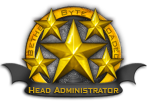Log in
Control Panel
|
|
|
|
Notifications
Who is online?
In total there is 1 user online :: 0 Registered, 0 Hidden and 1 Guest
None
Most users ever online was 156 on Wed Jul 03, 2019 11:22 am
None
Most users ever online was 156 on Wed Jul 03, 2019 11:22 am
Recent Members
Statistics
We have 42 registered users
The newest registered user is JanCarter
Our users have posted a total of 4444 messages in 2050 subjects
The newest registered user is JanCarter
Our users have posted a total of 4444 messages in 2050 subjects
Latest topics
BG Music
A Plan to Defeat Coronavirus Finally Emerges, But It’s Not From The White House
Page 1 of 1 • Share

From The Washington Post
Since the government can't get the job done, it's up to us to do the job. We have to keep following the CDC guidelines, keep up with the social distancing in order to save lives. Sure, we may not like it, sure we are going to miss being able to just hang out, but we will get to do this again soon if we keep doing what we have been doing. It's harder to be able to go back to normal if you or someone you love is dead.
Just Saying.

Lena H. Sun and William Wan of The Washington Post wrote:A national plan to fight the coronavirus pandemic in the United States and return Americans to jobs and classrooms is emerging — but not from the White House.
Instead, a collection of governors, former government officials, disease specialists and nonprofits are pursuing a strategy that relies on the three pillars of disease control: ramp up testing to identify people who are infected. Find everyone they interact with by deploying contact tracing on a scale America has never attempted before. And focus restrictions more narrowly on the infected and their contacts so the rest of society doesn’t have to stay in permanent lockdown.
But there is no evidence yet the White House will pursue such a strategy.
Instead, the president and his top advisers have fixated almost exclusively on plans to reopen the U.S. economy by the end of the month, though they haven’t detailed how they will do so without triggering another outbreak. President Trump has been especially focused on creating a second coronavirus task force aimed at combating the economic ramifications of the virus.
Administration officials, speaking on the condition of anonymity to describe internal deliberations, say the White House has made a deliberate political calculation that it will better serve Trump’s interest to put the onus on governors — rather than the federal government — to figure out how to move ahead.
“It’s mind-boggling, actually, the degree of disorganization,” said Tom Frieden, former Centers for Disease Control and Prevention director. The federal government has already squandered February and March, he noted, committing “epic failures” on testing kits, ventilator supply, protective equipment for health workers and contradictory public health communication. The next failure is already on its way, Frieden said, because “we’re not doing the things we need to be doing in April.”
On Thursday, White House spokesman Judd Deere said, “The President wants to see this economy open again so people can get back to work, but scientific data will drive the timeline on those decisions because his number one priority is to protect the safety and well-being of the American people.”
In recent days, dozens of leading voices have coalesced around the test-trace-quarantine framework, including former FDA commissioners for the Trump and George W. Bush administrations, Microsoft founder Bill Gates and top experts at Johns Hopkins, Columbia and Harvard universities.
On Wednesday, former president Barack Obama weighed in, tweeting: “Social distancing bends the curve and relieves some pressure. … But in order to shift off current policies, the key will be a robust system of testing and monitoring — something we have yet to put in place nationwide.”
And Friday, Apple and Google unveiled a joint effort on new tools that would use smartphones to aid in contact tracing.
What remains unclear is whether this emerging plan can succeed without the backing of the federal government. Some states such as Massachusetts and Utah are already trying to implement parts of it. In the absence of federal leadership — as happened last month with stay-at-home orders — other states may watch and follow suit. But without substantial federal funding, states’ efforts will only go so far
In South Korea, Taiwan, China and Singapore, variations on this basic strategy were implemented by their national governments, allowing them to keep the virus in check even as they reopened parts of their economy and society.
In America, testing — while still woefully behind — is ramping up. And households across the country have learned over the past month how to quarantine. But when it comes to the second pillar of the plan — the labor-intensive work of contact tracing — local health departments lack the necessary staff, money and training.
Experts and leaders in some states say remedying that weakness should be a priority and health departments should be rapidly shored up so that they are ready to act in coming weeks as infections nationwide begin to decrease. In a report scheduled for release Friday, the Johns Hopkins Center for Health Security and the Association of State and Territorial Health Officials — which represents state health departments — estimate 100,000 additional contact tracers are needed and call for $3.6 billion in emergency funding from Congress.
The CDC is researching how to increase contact tracing capacity, its director, Robert Redfield, said Friday in an NPR interview. But those efforts have not been reviewed by the White House, and the disease agency’s role has been diminished in the administration’s pandemic response. “We’re definitely in the middle of all of that. It’s premature for me to roll it out,” Redfield said.
Technology, like the Apple-Google partnership, is also being developed that could aid that effort, but it comes with civil liberty concerns that need to be resolved.
Unless states can aggressively trace and isolate the virus, experts say, there will be new outbreaks and another round of disruptive stay-at-home orders.
“All people are talking about right now is hospital beds, ventilators, testing, testing, testing. Yes, those are important, but they are all reactive. You are dealing with the symptoms and not the virus itself,” said Tolbert Nyenswah, who led one of the most successful contact tracing efforts in Africa during the 2014 to 2016 Ebola epidemic. “You will never beat a virus like this one unless you get ahead of it. America must not just flatten the curve but get ahead of the curve.”Creating An Army
Six years ago, Nyenswah watched an even deadlier disease, Ebola, tear through his homeland. Liberia’s president tapped him to lead its response, and Nyenswah began immediately hiring an army of surveillance officers to do “shoe-leather” tracing. It involved going door to door to find anyone who interacted with someone with a confirmed case of the hemorrhagic disease and persuading them to stay indoors, even providing food and services to make that more likely.
Testing on its own is useless, Nyenswah explained, because it tells you only who already has the virus. Similarly, tracing alone is useless if you don’t place those you find into quarantine. But when all three are implemented, the chain of transmission can be shattered.
Until a vaccine or treatment is developed, such nonpharmaceutical interventions are the only tools countries can rely on — besides locking down their cities.
In 2014, Nyenswah’s army of 4,000 public health workers used tracing to eradicate Ebola in Liberia under even more difficult circumstances. Many homes didn’t have phone lines, much less house numbers, street names or Zip codes to navigate by.
“We didn’t have the sophisticated systems you have in the U.S.,” Nyenswah said. “Many of the people we dealt with weren’t even literate, but we were able to win. What that tells you is that this can work.”
But to expand that in a country as large as the United States will require a massive dose of money, leadership and political will.
Nyenswah, who now lives in the United States and teaches at Johns Hopkins, has watched the disjointed U.S. response on TV with growing alarm.
“You cannot have leaders contradicting each other every day. You cannot have states waiting on the federal government to act, and government telling the states to figure it out on their own,” he said. “You need a plan.”Daunting math of transmission
When Vermont’s first coronavirus case was detected last month, it took two state health workers a day to track down 13 people who came into contact with that single patient. They put them under quarantine and started monitoring for symptoms. No one else became sick.
“It was a tidy bow,” recalled Daniel Daltry, one of the two health officers who did the work.
Within days, new cases were “coming in like dominoes,” Daltry said. By late March, his team was racing on a single day to trace the contacts of 12 patients, when an additional 30 cases landed on their desk.
He did the math: If each of those 30 patients had contact with even three people, that meant 90 people his crew would have to locate and get into quarantine. In other words, impossible.
This is the daunting math facing health departments nationwide. Since 2008, city and county health agencies have lost almost a quarter of their overall workforce. Decades of budget cuts have left the them unable to mount such a response. State health departments have had to lay off thousands more — an unintended consequence of federal officials delaying tax filings until July without warning states. Those federal filings generate state revenue.
In Wuhan, a city of 11 million, the Chinese had 9,000 health workers doing contact tracing, said Frieden, the former CDC director. He estimates in the United States, authorities would need roughly one contact tracer for every four cases.
Such large-scale tracing nationally could be possible if federal funding and guidance bolstered counties at the same time social distancing lowers the number of cases.
“We could use a stronger voice out of the White House to mobilize this nation,” Washington Gov. Jay Inslee (D) said Thursday. “In the second wave, we have to have testing, a resource base, and a contact-tracing base that is so much more scaled up than right now. It’s an enormous challenge.”Not waiting to act
In the absence of federal direction, Massachusetts last week unveiled a plan to begin building a contact tracing army.
Gov. Charlie Baker (R) partnered with an international nonprofit group based in Boston that has been waging this kind of public health campaign against contagious diseases including tuberculosis in Africa and HIV and cholera in Haiti. The nonprofit Partners in Health quickly put together a plan to hire and train 1,000 contact tracers. Working from their homes making 10 to 12 calls a day, they could cover up to 20,000 patients a day.
The group is paying new hires roughly the same salary as census takers, about $20 an hour. As of Tuesday — just four days after the initial announcement — the group had received 7,000 applicants and hired 150.
“People want to help. They’re tired of just sitting at home and waiting to be infected,” said KJ Seung, a program director for Partners in Health. “There’s a huge untapped resource of people in America if we would just ask.”
Utah has also taken action, reassigning government employees to increase contact tracing capacity, said state health department spokesman Tom Hudachko. State leaders are trying to pull together 1,200 more workers. San Francisco is trying to build a 150-person contact tracing team using city librarians, university staff and medical students.
“There needs to be a crash course in contact tracing because a lot of the health departments where this is going to need to happen are already kind of flat out just trying to respond to the crisis at hand,” said Tom Inglesby, director of the Johns Hopkins Center for Health Security.
Experts have proposed transforming the Peace Corps — which suspended global operations last month and recalled 7,000 volunteers to America — into a national response corps that could perform many tasks, including contact tracing.
On Wednesday, the editor in chief of JAMA, a leading medical journal, proposed suspending the first year of training for America’s 20,000 incoming medical students and deploying them as a medical corps to support the “test, trace, track, and quarantine strategy.”
Health workers who have been doing this kind of contact tracing for sexually transmitted diseases have proposed expanding an existing group of national disease investigation specialists — about 1,600 workers funded by the CDC and focused on ailments such as rectal gonorrhea — into a ready-made coronavirus tracing battalion. The national organization for local STD programs says $200 million could add roughly 1,850 specialists, more than doubling that current workforce.There’s an app for that
Technology could also turn out to be pivotal. But the invasive nature of cellphone tracking and apps raises concerns about civil liberties.
The technology could offer a version of what contact tracers do in interviews: build a contact history for each confirmed patient and find those possibly exposed.
Doing that digitally could make the process quicker — critical in containing an outbreak — and less laborious.
Singaporean police, for example, used security camera footage and ATM and credit card records to retrace people’s steps during the coronavirus outbreak there.
In China, authorities combined the nation’s vast surveillance apparatus with apps and cellphone data to track people’s movements. If someone they came across is later confirmed as infected, an app alerts them to stay at home.
South Korea and Israel have similarly deployed apps and cellphone technology. In Taiwan, authorities even placed virtual fences around those quarantined at home, alerting authorities if quarantined residents try to leave their homes or turn off their phone.
In the United States, about 20 technology companies are trying to create a contact tracing app using the geolocation data or Bluetooth pings on cellphones, said Dylan George, a former senior Obama administration policy adviser now advising one such effort.
Seattle-King County is in “very early discussions” with one group about using such contact tracing technology, said Jeffrey Duchin, a top county health official. Duchin said he would welcome any way to speed up the contact tracing work of his team, but said, “We have no real experience with them and can’t predict how well they will work.”
“These apps don’t solve the problem on their own, but they can definitely help as force multipliers,” said Crystal Watson, a Johns Hopkins researcher specializing in public health preparedness. “The problem is they come with huge civil liberties caveats that still need to be sorted out.”
Since the government can't get the job done, it's up to us to do the job. We have to keep following the CDC guidelines, keep up with the social distancing in order to save lives. Sure, we may not like it, sure we are going to miss being able to just hang out, but we will get to do this again soon if we keep doing what we have been doing. It's harder to be able to go back to normal if you or someone you love is dead.
Just Saying.

Create an account or log in to leave a reply
You need to be a member in order to leave a reply.
Page 1 of 1
Permissions in this forum:
You cannot reply to topics in this forum














































» Last thing you ate/drank
» What are you looking forward to right now?
» What are your plans for the day
» What are your plans for the day.
» 2023/24 NFL season
» Karen freakout compliation
» What NFL team do you support?
» NFL 2023 fixture release
» 2022-2023 NFL SEASON